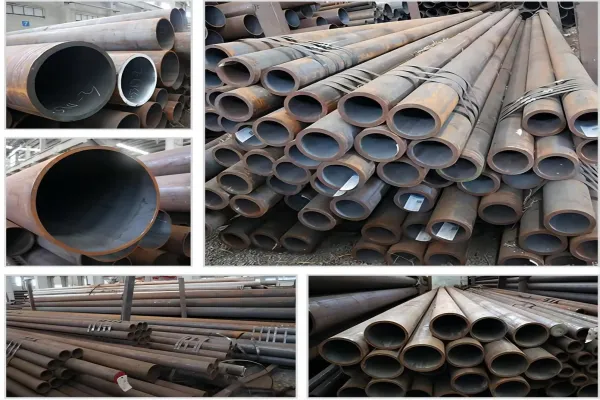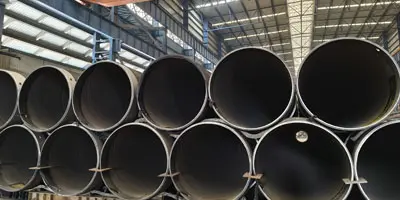What is Mild Steel Pipe (MS Pipe)?
Mild Steel Pipe (MS Pipe) is manufactured using low carbon steel (less than 0.25%). Due to the low carbon content, the steel pipe does not harden and is easy to work with. Since mild steel pipe is made of low carbon steel, it can be easily welded and formed into pipes and tubes of various shapes and sizes. These pipes are mainly used in industries and engineering applications where corrosive fluids are used. In addition, MS pipes are also used in drinking water supply, i.e., pipes, fire protection, and HVAC (heating, ventilation, and air conditioning). Mild steel does not corrode because its surface is coated with paint, varnish, and other metals, which makes it durable and can work in very harsh conditions. In addition, mild steel pipes can also withstand certain temperatures.
Both cold drawn and hot rolled bars are low carbon steel. Hard steel and mild steel are divided according to whether they have a yield point or not, because hard steel has no obvious yield point and plasticity compared to mild steel, and its control stress factor is lower than that of mild steel.
Characteristics of MS Pipes
Some notable features of mild steel pipes and steel tubes are high tensile strength, these pipes meet the American Society for Testing and Materials (
ASTM) specifications, MS pipes are very strong, low carbon content, can be easily welded, simple to manufacture, easy to use, not very expensive compared to other metals, and exist for 100 years or more. Some of the main applications of mild steel pipes are structural purposes, mechanical reasons, general construction, residential applications, planning transport bodies, fences, building structures, and water supply steel pipes.
Square mild steel pipes have notable features such as high quality, large consumption barriers, high strength, and easy deformation. Round MS pipes have found use in some applications, such as modern water pipelines, plant channels, agribusiness and water supply systems, incentive steel fences, street barriers, stop boundaries, fences, steel doors and windows, roadside railings, foundations and construction projects, water supply pipelines, etc.
Specifications of MS Pipe
|
Property
|
Specification / Range
|
Basis / Standard
|
|
Material Grade
|
IS 1239 (Part 1), IS 3589, ASTM A53 Grade A/B
|
IS, ASTM Standards
|
|
Pipe Type
|
ERW (Electric Resistance Welded), Seamless
|
Based on Manufacturing Method
|
|
Outer Diameter (OD)
|
15 mm – 609 mm (½” – 24”)
|
IS 1239: up to 150 mm; IS 3589: up to 609 mm
|
|
Wall Thickness (WT)
|
1.8 mm – 12.7 mm
|
As per IS 1239/IS 3589/ASTM A53
|
|
Length
|
6 meters standard (custom: 3m to 12m)
|
Market practice
|
|
Tensile Strength
|
330 – 410 MPa (Typical for MS)
|
IS 1239 / ASTM A53
|
|
Yield Strength
|
210 – 240 MPa
|
Depends on grade (A/B)
|
|
Standards Available
|
IS 1239 (Light, Medium, Heavy), IS 3589, ASTM A53, API 5L Gr A
|
Manufacturing & Application Based
|
|
Coating
|
Black (as rolled), Galvanized (GI)
|
IS 1239, IS 3589
|
|
End Type
|
Plain End, Beveled End, Threaded (with socket/cap)
|
Customer Requirement
|
|
Applications
|
Water, gas, air, fire-fighting, structural support
|
Industrial & Civil Construction
|
|
Weight per Meter
|
Varies by size (e.g., 25 mm OD, 3.2 mm WT = ~1.88 kg/m)
|
Based on IS 1239 / Pipe Weight Formula
|
|
Corrosion Resistance
|
Low (Black MS), Moderate (Galvanized)
|
Material property
|
|
Weldability
|
Excellent
|
MS is known for good weldability
|
|
Elongation
|
Min. 20% (on 5D gauge length)
|
IS 1239 / ASTM A53
|
Notes:
IS 1239 is typically used for nominal bore pipes for water, gas, and air lines.
IS 3589 covers large diameter pipes used in water and sewage applications.
ASTM A53 covers both seamless and welded black/galvanized pipes used in pressure and mechanical applications.
Advantages of MS Pipes
1. Good machinability
Mild carbon steel is very suitable for processing into parts of various complex shapes due to its low carbon content, soft structure, easy cutting, stamping, bending and welding.
2. Good welding performance
Low carbon steel is not prone to cracks or deformation during welding, and is suitable for a variety of welding processes such as arc welding, gas welding, and resistance welding.
3. Strong ductility and plasticity
Low carbon steel materials have good ductility and plasticity, and can withstand a certain degree of tensile, bending, and impact loads without breaking.
4. Low cost
Low carbon steel has a relatively low manufacturing cost, easy raw materials, and simple processing, so it is widely used in industrial manufacturing, such as in construction, automobiles, home appliances, and other fields.
5. Easy to form and cold process
In the cold rolling or cold drawing process, low carbon steel shows good processing stability and can be made into a variety of product forms such as plates, wires, and pipes.
6. Good magnetic properties
Low carbon steel has excellent magnetic permeability, so it is widely used as the core material of electromagnetic equipment such as motors, transformers, and relays.

What is Low Carbon Seamless Steel Pipe
Carbon steel seamless steel pipe is one of the most versatile steel pipes, which can also be called seamless steel pipe, structural steel pipe or carbon steel pipe. It is the most common steel pipe worldwide and is used for different purposes such as energy construction, large transportation projects, infrastructure support and water quality detection systems.
Seamless steel pipes are made of residual carbon or low carbon alloy steel. They are generally available in three standard sizes: conical, semi-circular and round. Each size has a different definition, but the bending radius is usually calculated based on the outer diameter. Of course, different categories of seamless steel pipes also have different thicknesses, ranging from 0.5 inches (1.5cm) to 4 inches (10cm).
The special feature of carbon steel seamless steel pipes is that they are manufactured without any welds and seams. This is because the production process of seamless steel pipes uses a precise pressing process, which is a heat treatment technology that compresses the raw materials into a complete structure through a rotating die and precise cooling and cutting, and no welding is used in this process.
Carbon steel seamless steel pipes can be used for many different industrial purposes, among which there are several main uses: structural steel pipes can be used for building structure support, such as river embankments, etc.; they can also be used for walls, heating and air conditioning; they can be used for water, sewage and hot water systems, most commonly gas pipelines; they can also be used for natural gas supply; seamless steel pipes can also be used in the automotive industry for the manufacture of pressure vessels, such as engines, etc.; carbon steel seamless steel pipes can also be used in the food industry for liquid and gas pipelines and storage containers for equipment such as granulators, biscuit machines, mixers, etc., and accessories can also be added for use in water quality testing instruments.
Frequently Asked Questions (FAQ)
What is the difference between Mild Steel and Carbon Steel?
Mild Steel has a lower carbon content, which makes it more malleable but less strong than other carbon steels.
Can Mild Steel Pipes be used for drinking water pipelines?
Yes, if the interior of the pipe is coated with certified anti-corrosion layers, they can be used for drinking water pipelines.
What is the lifespan of Mild Steel Pipes?
With proper maintenance and anti-corrosion treatment, the lifespan of Mild Steel Pipes can exceed 25 years.
Can Mild Steel Pipes be welded?
Yes, they are very suitable for welding and can be welded using common MIG or TIG methods.






 English
English Español
Español بالعربية
بالعربية











 Phone :
Phone :  Whatsapp :
Whatsapp :  Email :
Email : 


